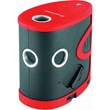
Buyers Guide To Planimeters
First conceptualized by Johann Martin Hermann in 1814, the planimeter is a genius invention brought to life by the Swiss mathematician Jakob Amsler-Laffon exactly 40 years later in 1854.
To put it simply, planimeters are used to accurately measure irregular 2D shapes on a map, Xrays, and other documents. It has come a long way from its first model, with a lot of professionals using mostly digital planimeter in surveying, mapmaking, and even agriculture.
Tamaya, Placom, and Lasico are the top planimeter brands in the market. Across brands, here are some things you have to consider when buying a planimeter:

1. Mechanical or Digital Planimeter
Mechanical planimeters are manual devices that usually consist of a base, tracer arm, pole arm, and a tracer lens. How it works is you anchor the base to a spot in your work area (the base has a sharp needle that you’ll use for anchoring), extend the pole arm, and trace the 2D shape with the tracer lens.
Digital planimeters essentially work like mechanical planimeters, except that they have a digital readout of measurements. A digital planimeter also lets you set your map scale and choose a unit of measurement to get a direct output in different units like km², eliminating the extra step of converting measurements.
Using a digital planimeter in surveying yields faster results, making it an ideal solution for surveyors and anyone else who needs fast and accurate results.

2. Types of Planimeter
Polar planimeters are the first type of planimeter invented. It has an arm that allows movement in a circular area and is attached to a base that is pinned down to a flat surface. The main disadvantage of this type of planimeter is the limited movement allowed by the pinned down base.
Roller planimeters, on the other hand, are attached to wheels that freely roll all over the area, making it easier to measure larger areas on documents. You are not restricted in terms of horizontal or vertical movements, and this is why it’s more commonly used nowadays than the polar planimeter.

3. Accuracy
Most planimeters have an accuracy level ranging from +/-0.1% to +/-0.2%. Although planimeters are highly accurate devices, the accuracy of results depends on two crucial factors: the accuracy of the map or document you’re working with and your tracing skills.

4. Maximum Measuring Range
The measuring range varies mostly according to the types of planimeter. Roller planimeters generally have longer measuring ranges, with some able to measure up to 98 x 12.5 feet HV range.
As for polar planimeters, the measuring range is directly proportional to the length of the tracer arm. Most polar planimeters have a 14 x 7 inch HV measuring range. If you’ll be working with large documents, it’s best to purchase a rolling planimeter to get a longer measuring range.
Where to Buy Planimeters
Construction tools and local hardware shops usually carry several kinds and brands of planimeters. If you don’t have time to spare, visit our website to see a large selction of planimeters for your needs.
Feel free to give us a call if you want to speak to one of our experts!


































